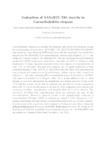Please use this identifier to cite or link to this item:
http://www.alice.cnptia.embrapa.br/alice/handle/doc/1071457| Title: | Evaluation of NANoREG TiO2 toxicity in Caenorhabiditis elegans. |
| Authors: | CASTRO, V. L. S. S. de  CASTANHA, R. F.   VALLIM, J. H.   |
| Affiliation: | VERA LUCIA SCHERHOLZ S DE CASTRO, CNPMA; RODRIGO FERNANDES CASTANHA, CNPMA; JOSE HENRIQUE VALLIM, CNPMA. |
| Date Issued: | 2016 |
| Citation: | In: ENCONTRO ANUAL DA SOCIEDADE BRASILEIRA DE PESQUISA EM MATERIAIS, 15., 2016, Campinas. [Abstracts...] Rio de Janeiro: Sociedade Brasileira de Pesquisas em Materiais, 2016. Resumo B4TJ. |
| Description: | Caenorhabditis elegans is a suitable invertebrate alternative to vertebrate assays for ecotoxicological evaluations. NANoREG TiO2 2883578/ JRCNM01001a/990407 was tested by using Nanoreg SOPToxicity test with the nematode Caenorhabiditis elegans for the NANoREG core nanomaterials (Kleiven and Oughton, 2015). The strain of C.elegans used is the wild-type N2. The pre-culturing was performed in modified S-BASE media plus cholesterol, incubate at 20ºC, in darkness with shaking for 3-5 days. Age-synchronized worms were exposed to concentrations of TiO2 0.01 to 100 mg/L. Because test solution had no good dispersion, it was sonicated during 15 min, 400 W, 20 kHz before the test. Each test concentration was assayed in 4 replicates in 24-well tissues culture plates, with a total test volume of 1 mL/well containing EPA reconstituted water, Escherichia coli OP50, TiO2 and 5-20 juvenile L1 C.elegans. After 96 h, it was added 0.5 mL of Rose Bengal to each well and heated the multidishes in a drying oven for 10 min at 80 °C to kill the worms. To be able to estimate the growth (%) it was prepared a plate with 30 worms for the measure at time 0h. Four endpoints were determined: recovery, fertility, reproduction, and growth after 96 h of incubation. The recovery, fertility and reproduction were not affected by any of the concentrations. However, growth seems to be significantly reduced at concentration 100 mg/L (84%) in relation to control (115%). Responses in C. elegans depending not only on the concentration tested, but also on the endpoint. Growth seems to be a more sensitive endpoint to C. elegans than others evaluated. |
| Thesagro: | Toxicologia |
| NAL Thesaurus: | Caenorhabditis elegans |
| Type of Material: | Resumo em anais e proceedings |
| Access: | openAccess |
| Appears in Collections: | Resumo em anais de congresso (CNPMA)  |
Files in This Item:
| File | Description | Size | Format | |
|---|---|---|---|---|
| 2016RA093.pdf | 49.64 kB | Adobe PDF |  View/Open |









